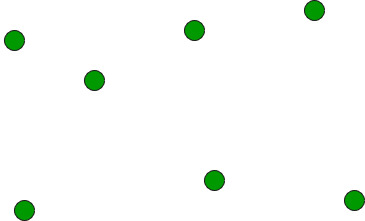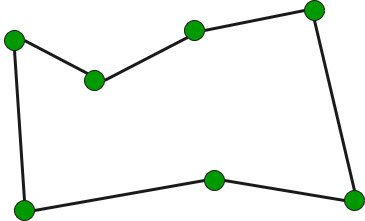给定一组点,将点连接起来而不交叉。


例子:
Input: points[] = {(0, 3), (1, 1), (2, 2), (4, 4),
(0, 0), (1, 2), (3, 1}, {3, 3}};
Output: Connecting points in following order would
not cause any crossing
{(0, 0), (3, 1), (1, 1), (2, 2), (3, 3),
(4, 4), (1, 2), (0, 3)}
强烈建议您最小化浏览器,然后自己尝试。
这个想法是使用排序。
- 通过比较所有点的y坐标找到最底端的点。如果存在两个具有相同y值的点,则考虑具有较小x坐标值的点。将最低点放在第一个位置。

- 考虑剩余的n-1个点,并按点[0]的逆时针顺序按极角对它们进行排序。如果两点的极角相同,则将最近的点放在第一位。
- 遍历排序的数组(按角度递增的顺序排序)会产生简单的闭合路径。

如何计算角度?
一种解决方案是使用三角函数。
观察:我们不在乎角度的实际值。我们只想按角度排序。
想法:使用方向来比较角度,而无需实际计算角度!
下面是上述想法的C++实现。
// A C++ program to find simple closed path for n points
// for explanation of orientation()
#include
using namespace std;
struct Point
{
int x, y;
};
// A global point needed for sorting points with reference
// to the first point. Used in compare function of qsort()
Point p0;
// A utility function to swap two points
int swap(Point &p1, Point &p2)
{
Point temp = p1;
p1 = p2;
p2 = temp;
}
// A utility function to return square of distance between
// p1 and p2
int dist(Point p1, Point p2)
{
return (p1.x - p2.x)*(p1.x - p2.x) +
(p1.y - p2.y)*(p1.y - p2.y);
}
// To find orientation of ordered triplet (p, q, r).
// The function returns following values
// 0 --> p, q and r are colinear
// 1 --> Clockwise
// 2 --> Counterclockwise
int orientation(Point p, Point q, Point r)
{
int val = (q.y - p.y) * (r.x - q.x) -
(q.x - p.x) * (r.y - q.y);
if (val == 0) return 0; // colinear
return (val > 0)? 1: 2; // clockwise or counterclock wise
}
// A function used by library function qsort() to sort
// an array of points with respect to the first point
int compare(const void *vp1, const void *vp2)
{
Point *p1 = (Point *)vp1;
Point *p2 = (Point *)vp2;
// Find orientation
int o = orientation(p0, *p1, *p2);
if (o == 0)
return (dist(p0, *p2) >= dist(p0, *p1))? -1 : 1;
return (o == 2)? -1: 1;
}
// Prints simple closed path for a set of n points.
void printClosedPath(Point points[], int n)
{
// Find the bottommost point
int ymin = points[0].y, min = 0;
for (int i = 1; i < n; i++)
{
int y = points[i].y;
// Pick the bottom-most. In case of tie, chose the
// left most point
if ((y < ymin) || (ymin == y &&
points[i].x < points[min].x))
ymin = points[i].y, min = i;
}
// Place the bottom-most point at first position
swap(points[0], points[min]);
// Sort n-1 points with respect to the first point.
// A point p1 comes before p2 in sorted ouput if p2
// has larger polar angle (in counterclockwise
// direction) than p1
p0 = points[0];
qsort(&points[1], n-1, sizeof(Point), compare);
// Now stack has the output points, print contents
// of stack
for (int i=0; i 输出:
(0, 0), (3, 1), (1, 1), (2, 2), (3, 3),
(4, 4), (1, 2), (0, 3), 如果我们使用O(nLogn)排序算法对点进行排序,则上述解决方案的时间复杂度为O(n Log n)。
来源:
http://www.dcs.gla.ac.uk/~pat/52233/slides/Geometry1x1.pdf